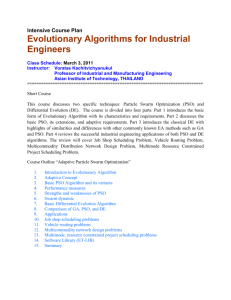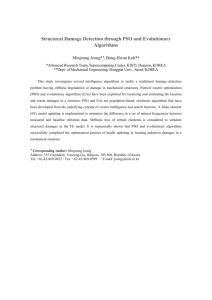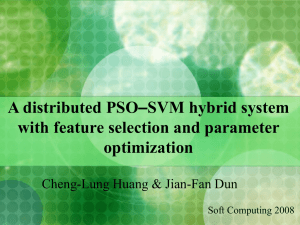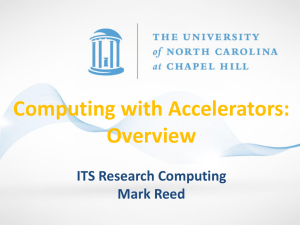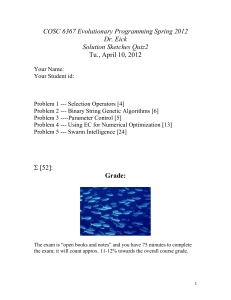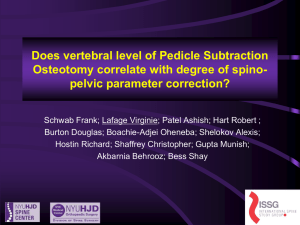GPU OpenCL Particle Swarm Optimization: Implementation & Performance
advertisement
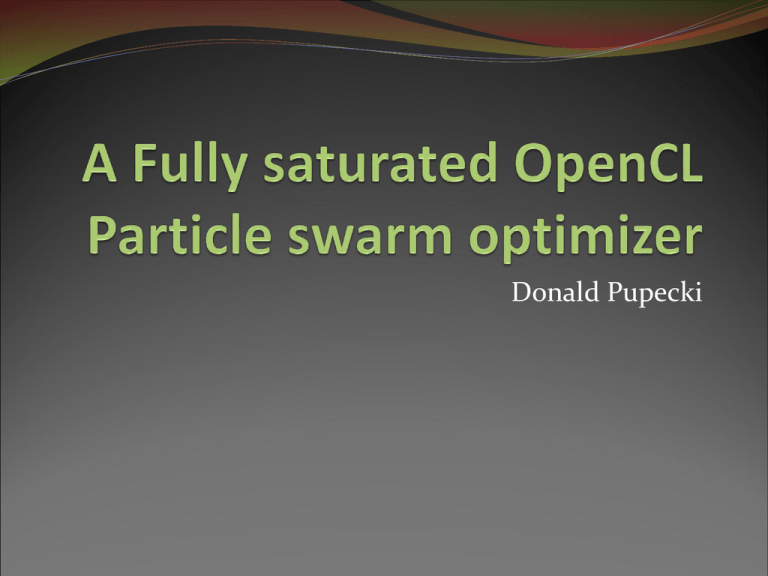
Donald Pupecki Why GPUs? GPUs are scaling faster than CPUs[1] [2] Intel recently wrote a paper claiming a two year old GPU was “only 10x faster” than their top-end CPU. Why OpenCL? Portable. Can run on most parallel platforms CPU GPU FPGA Cell B.E. Industry Wide Support Binding For many languages Why PSO? Particle Swarm Optimization Created in 1995 by Kennedy, Eberhart , Shi[5][6] Inspired by BOIDS, a bird flocking simulation by Craig Reynolds[3][4] Provides good exploration, exploitation sometimes requires parameter tuning. [7] A subset of Swarm Intelligence, which is itself a subset of Evolutionary Computation Video: http://vimeo.com/17407010 Is it parallelizable? The PSO, like most evolutionary computations is iterative. General process: Init while not term_conditions update position, velocity recalculate fitness update local bests Within each iteration there is a lot to do. Pick 2 random numbers Uniform Rand R1,2 [0,1] Update Pos/Vel for each dimension Veli+1 = W(Veli) +C1*R1*(Besti-Posi) + C2*R2*(Gbesti-Posi) Posi+1 += Veli+1 Update Fitness Sphere, Rast, Rosen, Grien, Schwefel Ackley or Sum of Powers Update Best Position If Posi>Besti, Posi = Besti If Posi>Gbest, Gbest = Posi Parallel Gotchas Bank conflicts[18] Divergent Warps Struct Sizes Coalescing Debugging SIMD No Branch Prediction Goals: Implement More Test Functions The previous version of this work only implemented 4 test functions. More non-parabolic test functions could help confirm the soundness of the algorithm. Test Functions Implemented Sphere Unimodal, Symmetric Rosnebrock Multimodal, Nonsymentric, Banana Shaped Rastragin Highly Multimodal, Symmetric Grienwank Regularly Distributed Minima Ackley Highly Multimodal, Funnel Shaped Schwefel Globally distant minima Sum of Powers Unimodal, non Symmetric [14][15] Goals: Shift Test Functions PSOs have a tendency to flock to the middle. [10] Remedied by “Region Scaling”[10][11][12] or “Center offset” approach. Used center offset with an offset of 2.5 Goals: More Parallelism Version 1.0 only does fitness calculations over Num Particles. Dimensional Calculations almost all contain products or sums over all dimensions and should be done in parallel and combined with a reduction. Goals: Move Everything to Card Less than 1/10th of the time in the 1.0 version was spent doing calculation. Method Time Data xferred WriteBuffer WriteBuffer WriteBuffer WriteBuffer WriteBuffer rast__k3_ATI RV7701 ReadBuffer ReadBuffer 0.08559 0.07935 0.07701 0.07851 0.07641 0.04503 0.02778 0.02052 2.34 2.34 0.23 2.34 0.08 0 2.34 2.34 OCLPSO 1.1 Get everything to the card! Needed to implement a LCRNG on card. Eliminated large data transfers. Added hill climber to fall back on. Got inconsistent results. Note on synchronizations. Barrier, Mem Fence, FP Atomics, Compute Capability 2.x and the lack of global sync. OCL PSO 2.0 Rewrite. Introduced the Fully Saturated concept. Compute Units are now self contained. All dimensions of all particles of all swarms are evaluated in parallel. OCLPSO 2.0 vs. CUDA PSO 2.0 The CUDA PSO[16] [17] was submitted for the GECCO competition on GPGPGPU.com It features a ring topology for its bests calculation. OCLPSO 2.0 vs. SPSO The 2006 Standard PSO was written by Clerc and Kennedy. Pretty frills-free compared to newer (2010) Standard PSO codes or TRIBES. Non-parallel but extremely efficient. Conclusions OCL PSO 2.0 performs competitively as compared to CUDA PSO and trumps SPSO. This is despite its lack of neighborhood bests(it uses only a global best). This is also without the hill climb component as I needed to strip as much complexity out as I could in the final rewrite. Future work Re-implement hill climber, it was a great help for peaks. Re-add neighborhoods. Implement on newest generation of CUDA 2.x cards supporting global floating point atomics Implement TRIBES on the GPU. References [1] Nvidia, “TESLA DPU computing: Supercomputing at 1/10th the Cost.” http://www.nvidia.com/docs/IO/96958/Tesla_Master_Deck.pdf , 2011 [2] Nvidia, “Why Choose Tesla,” http://www.nvidia.com/object/why-choose-tesla.html, 2011 [3] BOIDS paper or wiki:boids http://www.red3d.com/cwr/boids/ [4] Reynolds, Craig (1987), "Flocks, herds and schools: A distributed behavioral model.", SIGGRAPH '87: Proceedings of the 14th annual conference on Computer graphics and interactive techniques (Association for Computing Machinery): 25–34 [5] Kennedy, J.; Eberhart, R. (1995). "Particle Swarm Optimization". Proceedings of IEEE International Conference on Neural Networks. IV. pp. 1942–1948. doi:10.1109/ICNN.1995.488968. http://www.engr.iupui.edu/~shi/Coference/psopap4.html. [6] Shi, Y.; Eberhart, R.C. (1998). "A modified particle swarm optimizer". Proceedings of IEEE International Conference on Evolutionary Computation. pp. 69–73. [7] Clerc, M.; Kennedy, J. (2002). "The particle swarm - explosion, stability, and convergence in a multidimensional complex space". IEEE Transactions on Evolutionary Computation [8] M. Nobile. “Particle Swarm Optimization”, http://vimeo.com/17407010, 2011 References – Cont. [9] M. Clerc, Confinements and Biases in Particle Swarm Optimization. http://clerc.maurice.free.fr/pso/ , 2006. [10] C. K. Monson and K. D. Seppi, "Exposing Origin-Seeking Bias in PSO," presented at GECCO'05, Washington, DC, USA, 2005, pp. 241-248. [11] P. J. Angeline. Using selection to improve particle swarm optimization. In Proceedings of the IEEE Congress on Evolutionary Computation (CEC 1998), Anchorage, Alaska, USA, 1998. [12] D. K. Gehlhaar and D. B. Fogel. Tuning evolutionary programming for conformationally flexible molecular docking. In Evolutionary Programming, pages 419–429, 1996. [13] D. Pupecki, “OpenCL PSO, Development, Benchmarking, Lessons, Future Work,” 2011. http://web.cs.sunyit.edu/~pupeckd/oclpsopres.pdf [14] Molga, M., Smutnicki, C., 2005. “Test functions for optimization needs”, http://www.zsd.ict.pwr.wroc.pl/files/docs/functions.pdf [15] Pohlheim, Hartmut. Genetic and Evolutionary Algorithm Toolbox for usewith MATLAB . Technical Report, Technical University Ilmenau, 1998. [16] L. Mussi, F. Daolio, and S. Cagnoni. Evaluation of parallel particle swarm optimization algorithms within the CUDA architecture. Information Sciences, 2011, in press. References – Cont. [17] L. Mussi, Y.S.G. Nashed, and S. Cagnoni. GPU-based Asynchronous Particle Swarm Optimization. Proc.GECCO 2011, 2011. [18] NVIDIA, OpenCL Programming Guide for the CUDA Architecture, http://developer.download.nvidia.com/compute/cuda/3_1/toolkit/docs/NVIDIA_OpenCL_Program mingGuide.pdf, 2011 [19] M. Clerc. TRIBES - un exemple d’optimisation par essaim particulaire sans param`etres de contrˆole. In Optimisation par Essaim Particulaire (OEP 2003), Paris, France, 2003.
